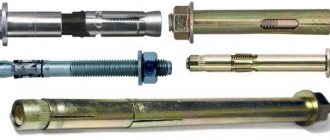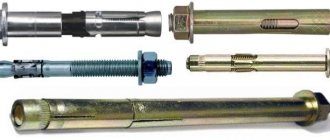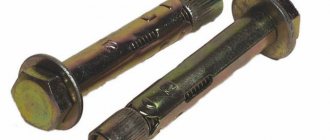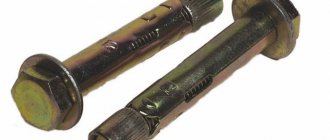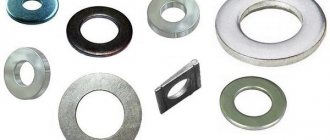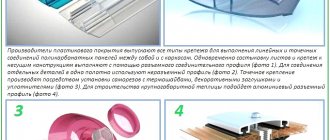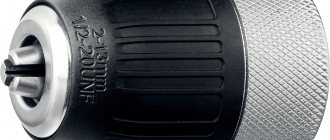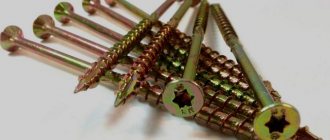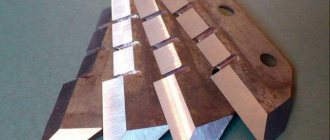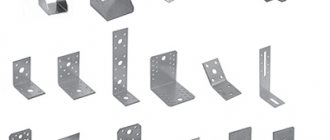Anchors for concrete are special fasteners necessary for reliable fixation of various objects and elements on concrete structures. Fastening elements are used where the strength of the walls does not allow the use of screws or nails. Usually, equipment and furniture are attached to walls in this way; they are also relevant for installing doors and windows.
Externally, a concrete anchor looks like a bolt. It is made of galvanized or stainless steel in the shape of a cylinder with a cone-shaped extension at the end of the fastening. The spacer part opens into the concrete after installation and ensures maximum density between the elements and guarantees reliability.
The concrete anchor is installed in a hole of the required size. The high holding capacity of the anchor is ensured by the force of friction, gluing using a special composition, and the interaction of the thrust element with the inner walls of the hole.
Working principle and application
Concrete is a porous material with a heterogeneous structure. And in the places of fastening, various forces appear - twisting, bending, shearing, shearing, compression, tearing. The concrete anchor takes over them, distributing them together with the supporting structure.
Basic principles of operation of concrete anchors:
- At the moment of interaction between the base material and the anchor, a frictional force appears - the expansion is carried out with dowels and metal collets.
- When, at the depth of anchoring, the material provides resistance to fracture or crushing - due to collet bushings on the fasteners, the curved shape of the rod, and expansion.
- Loads at the point of contact between the base and the rod are compensated by tangential stresses during embedding or gluing - this is how smooth, adhesive anchors work.
Anchors for concrete can be of different designs, types, sizes. They are made from special steel according to GOST and coated with a layer of anti-corrosion agent. The rod can be 6-20 millimeters in diameter and up to 220 millimeters long.
Any anchor includes the following parts:
- The bolt itself
- Cone with a layer of thread inside
- Bushing with special cutouts
Anchors perform a constructive or load-bearing function. The load-bearing function is implemented in cases of connecting floor slabs, beams, columns, balcony consoles, landings and flights, finishing and wall panels, engineering equipment, communications, hoods, ceiling lamps, etc. Anchors are also used for installing joists on concrete or hollow-core floors. They are used to attach electrical equipment and hanging furniture to walls.
Structural fasteners are used to counteract the displacement of parts of the assembly if their stability is guaranteed by their own weight; anchors are also relevant when straightening in construction.
Types and types of anchors and methods of their fastening
Anchors for concrete can be very different, using one or more acting forces - emphasis, intermolecular bonding during the gluing process, friction, bending, compression, etc. Depending on their purpose, concrete anchors can be frame, ceiling, foundation or universal. In shape - curved and straight, with a prefabricated or solid structure.
The surface of the anchor can be corrugated or smooth. There are different types of fasteners depending on the contact area - those that are used for porous materials and those that are used for dense ones. According to the installation method, anchor fasteners for concrete may involve through connection, gluing, hammering, screwing, etc.
The material from which the hardware is made is of great importance. If it is steel of strength class 6.8 or higher, coated with an anti-corrosion coating, then the fastening will be as strong as possible. But brass will not withstand serious vertical loads.
Spacers
Expansion anchors for concrete are usually used with nuts, here the working force is the friction force. They are a small threaded pin with a cone-shaped tip and a sleeve. When the fastener is screwed into the base, it wedges and firmly holds the fastener in the monolith.
The main advantages of such anchors: the ability to perform through installation, lightness and simplicity of installation, excellent load-bearing capacity. Wedge anchors are chosen mainly for dense concrete; they sink deeply and cannot be used a second time.
If the anchor bolt has a hook (bracket) installed at the end instead of a nut, the mount is suitable for attachments. Wedge anchors come in sleeve and sleeve types. Such a bolt looks like a bushing with special cutouts; at the end it can be made with a stud with a conical extension or a wedging nut. Used for medium and high density substrates. A small contact area, even with a minimum diameter of the product, makes it possible to withstand significant loads.
The anchor bolt with nut can be electrogalvanized (KA), hot-dip galvanized (HAK), and also have acid-resistant properties (KAN). This also includes screw anchors made of stainless steel (RAR).
Drivers
Drive-in concrete anchors are chosen for dense concrete. These are short bolts with an internal cone and metric threads. The fastener wedges the base when a pin or bolt is screwed into the concrete; the fastener does not protrude onto the surface.
Installing anchors in concrete using this type of bolts is relevant when installing ducts, ceiling air ducts, and installing engineering equipment. Before hammering an anchor into a concrete wall, drill a corresponding hole. Then they hammer in the hardware, use a punch-rim to wedge it, and screw in a threaded rod of the required length.
This type of anchor includes a dowel-nail and a ceiling anchor. It is convenient to attach suspensions, slats, and Armstrong ceilings to them. Fasteners are often used as fireproof or vandal-proof, since the bolt is non-removable.
Frame
Used for fastening door and window frames. The sleeve is made with a cut along its length; a small wedging nut, during the tightening process, presses the structure well against the opening, bringing it to the desired position. To protect against displacement and rotation around its own axis, there are stops at the top of the sleeve.
Self-tapping screws for concrete
Here, the reliability of the connection is ensured by threads running along the entire length of the bolt. During the process of screwing into the concrete base, a powerful resistance to tearing or shearing of the product is created. Therefore, when using this type of fastener, a very high load-bearing capacity is observed. The self-tapping screw can easily take up to 100 kilograms of load, is very reliable in operation and easy to install.
Expanding
In everyday life, this type of anchor is called a “butterfly” (aka Molly bolt). Used for mounting cornices, shelves, lamps, paintings and other elements in hollow structures with low load-bearing capacity. The collet on the screw or bolt is made in the form of a wedging skirt, which, in the process of screwing the rod into the base, rests against the inside of the base cavity. On the outside of the collet, special spikes are embedded in the concrete, which prevent the bolt from moving or turning during installation.
Chemical anchor
The anchor bolt for concrete is made in the format of a semi-liquid mass that quickly hardens. It is with this mass that the bolt or pin is glued into the monolith. Thanks to the composition, it is possible to ensure a reliable connection between the base and the bolt without local or point stresses, but with a uniform distribution of the load along the entire length of the fastener.
Chemical anchors for concrete do not provoke internal stress at all, significantly reducing the risk of destruction and deformation.
Screw
The design of the screw fastener, which is very easy to use, differs from all other anchor-type products. The slots on the spacer sleeve of such an anchor, which ensure its expansion during installation, are made in its middle part and have a weakened design. The lower part of such a sleeve is a nut into which the anchor bolt is screwed, compressing it along its length and ensuring the opening of the petals.
Screw anchors are called anchors of different designs.
The process of installing a screw anchor bolt can also be seen in the video. Such an anchor can be fastened in “weak” materials: porous concrete, brick, etc.
Dimensions and characteristics of anchor bolts
Before deciding which anchor is best for concrete in performing specific tasks, it is necessary to consider not only the variety of designs, but also the sizes, because fasteners can be of different lengths and diameters.
Classification of anchors by size:
- Small – cross-section up to 8 millimeters/length up to 55
- Medium anchors – up to 12/120 millimeters
- Large - with maximum dimensions of diameter 24 and length 220 millimeters
An anchor bolt for concrete can have different sizes: the characteristics are determined by three indicators. So, if we decipher the marking M8 10/60-115, then it will be: the diameter of the thread of the anchor M8, the outer diameter 10 (this is the diameter with which the hole for fastening is drilled, this is the diameter of the drill), the length of the anchor is 115 millimeters, the approximate thickness of the element that it is planned to strengthen - 60 millimeters.
All technical characteristics of anchors are indicated in the table, these can be weight, maximum torque and permissible bending moment, minimum pull-out force, optimal loads, distance between axes and to the edge, etc. In accordance with all these parameters, suitable products are selected and high-quality fastening to concrete with anchors is performed.
Drivers
A drive-in anchor is the simplest anchor-type fastener, the design of which consists of a spacer sleeve with a conical-shaped internal hole. To install such an anchor bolt at the required point in the building structure, it must be hammered into the mounting hole, and then a threaded element must be screwed into it, which will ensure the loosening of the bushing petals.
The material for the manufacture of such fasteners, the correct installation process of which can be seen in the video, can be galvanized steel or brass.
Attaching a drive-in anchor
» data-lazy-type=»iframe» src=»data:image/gif;base64,R0lGODlhAQABAIAAAAAAAP///yH5BAEAAAAALAAAAAABAAEAAAIBRAA7″>
Installation instructions
Before fixing the anchor bolt in concrete, you need to prepare the tools. To complete the work you will need: a wrench, a construction vacuum cleaner, a drill with a hammer function or a rotary hammer, a concrete drill, a hammer.
Drilling
First, the base is carefully marked for future drilling locations. Here you need to do everything as accurately as possible, since after installation it is not possible to remove the anchor bolt from the concrete - the fixation is very strong. Next, according to the markings, holes of the required length are drilled in the concrete (measured along the spacer part of the bolt), installing a limiter on the drill.
The distance from the edge of the wall should be at least 2.5 times the depth of the hole. Next, the holes need to be cleaned with a vacuum cleaner, compressed air from a can, or a rubber blower. If you cannot remove the crumbs without leaving a residue, you can deepen the hole by 1-2 centimeters.
Installation of anchor with nut
The spacer part of the bolt is inserted into the base and driven in with a hammer until it is completely immersed in the concrete (so that the edges are flush with the wall). Then a threaded rod or bolt is inserted, the nut is tightened, twisting as much as necessary so that further turning is impossible.
It is advisable to learn in advance how to use a specific type of fastener. Manufacturers may set the maximum torque, in which case a torque wrench will be needed. Tightening all the way when working with some substrates (aerated concrete, foam concrete) can cause deformation and destruction of the material.
Chemical anchor installation
To install chemical fasteners in concrete, you need a slightly modified set of tools: you will need a hammer drill, a wrench, a construction vacuum cleaner, as well as threaded rods, glue or capsules, and a mounting gun. For a large number of fasteners, glue is chosen; the choice of capsules (ampoules) is relevant where small volumes of work are planned.
First, mark the base, drill and clean the holes. Before pouring the adhesive solution into the concrete, it is advisable to screw in a mesh sleeve, thanks to which the chemical substance will be retained inside. Then you need to fill the holes 2/3 with glue (using a mounting gun) or install the capsules, insert the pin, gradually screwing it in to evenly distribute the adhesive. Now you need to wait until the glue dries and only then tighten the nut with a wrench.
Machine foundation price
If the machine is large and heavy enough, the cost of construction work will be quite significant. It is best to start building the foundation of the machine immediately after concluding a contract for the supply of the machine, by requesting a foundation drawing from the manufacturer. In this case, as a rule, there are 4-8 months to select an experienced work contractor, agree on an estimate and a contract for the manufacture of the foundation
It is important not to delay the start of work until the machine is manufactured. Otherwise, you will have to postpone the start of installation, commissioning and commissioning for the period of approval, production and hardening of the foundation
As a result, this may result in downtime of expensive equipment.
Pros and cons of use
The main advantages of using anchor bolts for concrete are maximum reliability and strength of structures. Anchors can withstand enormous loads and guarantee high-quality fastening in concrete with characteristics that cannot be achieved using other types of fasteners.
The main advantages of concrete anchors:
- Resistance to deformation and corrosion
- Lightness, simplicity and high speed of installation
- Resistance to dynamic and static loads of various types
- Large selection of anchors by length, diameter, type of fastening, load, function, shape, material, etc.
Selecting an anchor bolt for a particular task is not difficult. There are no obvious disadvantages to this type of fastener. Unless you need to remember some features: the importance of accurate markings, the correct selection of drills for concrete and determining the depth of the hole, the need to use a certain set of tools.
General recommendations
In order to correctly install anchor bolts, it is necessary to take into account the type and strength of the base, select the optimal type of anchor for a particular part and determine its load capacity.
And although some types do not require high precision hole drilling (for example, expanding), the more accurate it is, the more reliable the anchor’s adhesion to the base.
Information to note : Liquid glass , Solvent 646, white spirit.
Anchor bolt. Installation, principle of operation.
For foam concrete
Foam concrete is used today in many areas due to its poor flammability, low density, excellent thermal insulation properties and resistance to temperature changes of the material. The structure of the foam block consists of a large number of frozen bubbles. Screws, dowels, and self-tapping screws can be used to fasten the material. The highest level of reliability of foam block fastening is provided by plastic and chemical anchors.
How to install an anchor bolt in concrete
The whole process is quite simple, the main thing is to take the measurements correctly and implement everything as accurately as possible. But there are several nuances that need to be taken into account.
Practical tips for installing anchors in concrete:
- The strength of the fastener is influenced not only by the anchor, but also by the quality of the base material (concrete in this case), proper preparation for installation, taking into account the material of the attached structure and the design of the bolt itself.
- If a layer of finish is applied to the wall, the hole must be deeper because the finish is usually less durable than concrete.
- It is advisable to take a drill 0.5 millimeters thinner than the diameter of the future hole.
- When working with a hammer drill, it is best to use a tip made of a special carbide material.
- Read the instructions carefully - the packaging with anchors should indicate the permissible force and the maximum number of revolutions.
- When screwing the anchor into foam concrete or aerated concrete, under no circumstances twist it all the way, as the material may collapse.
Eternal fastener: concrete dowel
A dowel is a spacer element made of polypropylene or nylon, which is similar in function and performance to an anchor. It cannot be used independently; it is fixed in concrete with special nails or self-tapping screws. To strengthen the fixation, it is often performed with spikes or antennae.
This type of fastening is used where there are not too large loads on the concrete - fastening shelves, TV hooks, lighting fixtures. The dowels are driven into the concrete wall with a hammer, and the screws are screwed in with a screwdriver or screwdriver. You will also need a regular hammer to drive in nails.
You can also find dowel nails designed for use with a mechanical gun. The fasteners in concrete are made of metal; in appearance, they somewhat resemble a bullet. Relevant where you need to hang a large number of small items.
Concrete dowel: fast but durable
Pins are concrete screws that are most often used to install fasteners near the edges of a concrete wall. The fastener does not require additional fixation; it is screwed into the hole, where a little epoxy glue is first poured. There is no need to drill holes - the dowel can be screwed directly into the concrete wall. If you still need to make a hole in concrete, then it is better to choose a drill (a hammer drill can damage the wall).
They screw it in with a screwdriver - and after that it is no longer possible to unscrew the dowel back. Therefore, preliminary marking must be done especially carefully.
Anchor stud with hex head
This is a classic bolt and washer that screws into a coupling with longitudinal slots at the end. The tail cone-shaped nut serves as a spacer element.
Installation is standard - drill a hole, clean it, insert an anchor with a suspended part and lightly tap it. All that remains is to tighten the anchor bolts a few turns - the nut fits into the coupling with a cone and pushes it apart.
Anchor stud - installation diagram
The scope of application is the same as that of previous types - fastening heavy structures to a base made of concrete, stone and solid brick.
This type of bolt may end in a ring or hook. They allow you to simply hang structures after installing the anchor, otherwise there are no differences.
